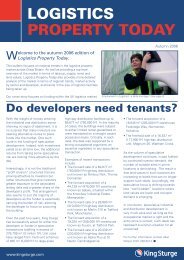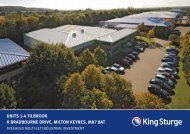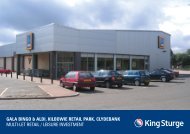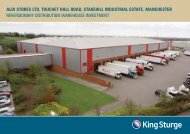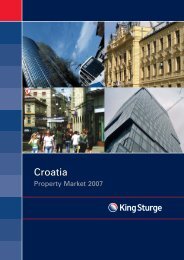South Coast Metropole South Coast Metropole - King Sturge
South Coast Metropole South Coast Metropole - King Sturge
South Coast Metropole South Coast Metropole - King Sturge
Create successful ePaper yourself
Turn your PDF publications into a flip-book with our unique Google optimized e-Paper software.
Retail and leisure market review<br />
On a macro level, the retail sector fared extremely<br />
well in 2007. Despite the cumulative effects of<br />
five interest rate rises over a short space of time,<br />
rising energy costs, the wettest summer on record<br />
and the well-documented credit crunch, consumer<br />
confidence remained remarkably robust. Monthly<br />
like-for-like retail sales were ahead of the previous<br />
year for every month during 2007.<br />
Retail sales monitor. BRC-KPMG total and LFL retail sales<br />
vs ONS retail sales value and volume (seasonally adjusted<br />
7%<br />
6%<br />
5%<br />
4%<br />
3%<br />
2%<br />
1%<br />
0%<br />
Jan<br />
07<br />
Feb<br />
07<br />
Mar<br />
07<br />
Apr<br />
07<br />
BRC total retail sales<br />
Source: <strong>King</strong> <strong>Sturge</strong><br />
May<br />
07<br />
ONS retail sales volume<br />
Jun<br />
07<br />
Jul<br />
07<br />
Aug<br />
07<br />
Sep<br />
07<br />
Oct<br />
07<br />
BRC LFL retail sales<br />
Nov<br />
07<br />
ONS retail sales value<br />
Contrary to most media reports (many of which<br />
seem determined to talk the UK economy into<br />
recession), this strong performance continued<br />
to the all-important Christmas period. The British<br />
Retail Consortium (BRC) reported that total sales<br />
growth for December was 2.3% year-on-year, or<br />
0.3% on a like-for-like basis. Doom-mongers may<br />
point to the fact that the rate of growth was lower<br />
than in previous years but this misses the point.<br />
The fact that the sector reported any growth at all,<br />
against extremely tough comparatives of 2005 and<br />
2006 and defied weakness in the wider economy,<br />
marked a very solid performance.<br />
As ever, there were significant performance<br />
disparities between both retail sub-sectors and<br />
individual operators. In simplistic terms, food<br />
retailers fared very well, while the clothing sector<br />
struggled. In bulky goods, DIY was strong, while<br />
electricals and furniture were weak. As discretionary<br />
purchases, these sectors tend to be the first to<br />
suffer from a forthcoming downturn.<br />
While retail trading generally exceeded expectations<br />
last year, few retailers are under any illusions<br />
Dec<br />
07<br />
Jan<br />
08<br />
140<br />
135<br />
130<br />
125<br />
120<br />
115<br />
Index 2000 = 100<br />
that 2008 will prove anything other than difficult.<br />
Consumer confidence is already showing signs of<br />
weakening, while retailers are bracing themselves<br />
for margin-eroding cost inflation (eg cost of raw<br />
goods and energy). This year has already seen a<br />
number of retail casualties, with high street names<br />
including Dolcis (footwear), Select (value fashion),<br />
Elvi (plus-size fashion), The Works (discount<br />
books) and Ponden Mill (soft furnishings) going<br />
into administration. However, for all the downturn<br />
in retail sales and belt-tightening by retailers, it is<br />
important to stress that the underlying occupational<br />
market is still holding up relatively well.<br />
Trends in house prices, retail sales and housing equity<br />
withdrawal (HEW)<br />
30%<br />
25%<br />
20%<br />
15%<br />
10%<br />
5%<br />
0%<br />
2002<br />
2003<br />
2004<br />
Y-on-Y house price growth<br />
Source: nationwide/ONS/Bank of England<br />
2005<br />
2006<br />
2007<br />
Y-on-Y retail sales growth<br />
HEW as % of income<br />
A strong occupational market was the key brightspot<br />
for an otherwise difficult retail property market in<br />
2007. According to the IPD Annual Digest, total<br />
returns in retail fell by 6.1% last year, the worst<br />
annual performance since 1990. This was fuelled<br />
by a 10.1% slump in capital values, the first time<br />
growth had been in negative territory since 2001.<br />
On a more positive note, the strong occupier market<br />
resulted in a 2.1% increase in rental values.<br />
Internet shopping continues to grow exponentially,<br />
but rather than representing a threat to the High<br />
Street, the trend is, if anything, helping the high<br />
street retailers: 14% (7% 2006) used the Internet<br />
for most of their Christmas shopping in 2007,<br />
with 74% using the web for at least one purchase<br />
(Source RLI). Some 72% of retailers (51% 2006)<br />
now provide online stores to complement their high<br />
street businesses.<br />
Although these figures are ostensibly poor, we<br />
believe that this marked a correction in the market,<br />
21



